Unlock the hidden potential of your trading decisions by mastering the 10 essential steps to interpret the MACD indicator in Forex trading.
Discover how each step can provide you with a deeper understanding of market trends and momentum shifts, guiding you towards more informed trading strategies.
Dive into the intricate world of MACD interpretation to uncover the key to unlocking profitable opportunities in the dynamic Forex market.
Understanding MACD Indicator Basics
When delving into the fundamentals of the Moving Average Convergence Divergence (MACD) Indicator for Forex trading, it's essential to grasp its core principles to navigate market trends effectively.
The MACD indicator combines fast and slow Exponential Moving Averages (EMAs) with a signal line, aiding traders in identifying trends within the Forex market. By utilizing the MACD, traders can gauge momentum shifts and potential trend reversals, crucial for making informed trading decisions.
Understanding the basics of the MACD indicator is paramount for interpreting price movements accurately. Its calculations, based on EMAs, offer insights into market trends and strength, enabling traders to analyze crossovers, divergences, and overbought/oversold conditions for strategic entries and exits.
Calculating MACD Line and Signal Line
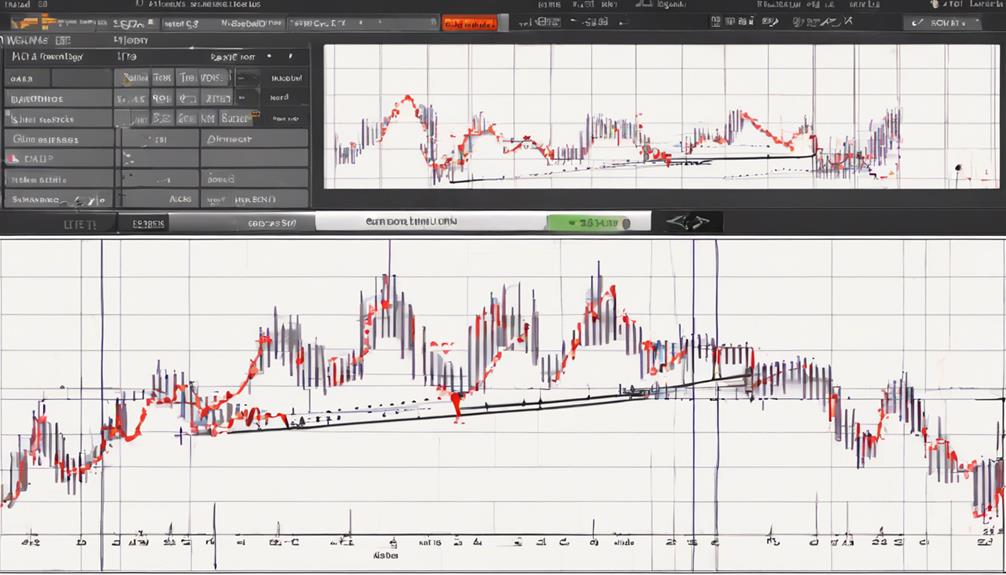
To calculate the MACD line and signal line, subtract the 26-period Exponential Moving Average (EMA) from the 12-period EMA and then derive a 9-day EMA of the MACD line for the signal line in Forex trading.
The MACD line represents the difference between these two EMAs, providing insights into the momentum of a currency pair. The signal line, a 9-day EMA of the MACD line, acts as a trigger for buy or sell signals.
Positive MACD values indicate a bullish trend, while negative values suggest a bearish trend. Understanding these lines helps traders identify overbought/oversold conditions, guiding decisions on entering or exiting trades based on potential price reversals.
Mastering the relationship between the MACD line and the signal line is crucial for effective use of the MACD indicator in Forex trading.
Identifying Signal Line Crossovers
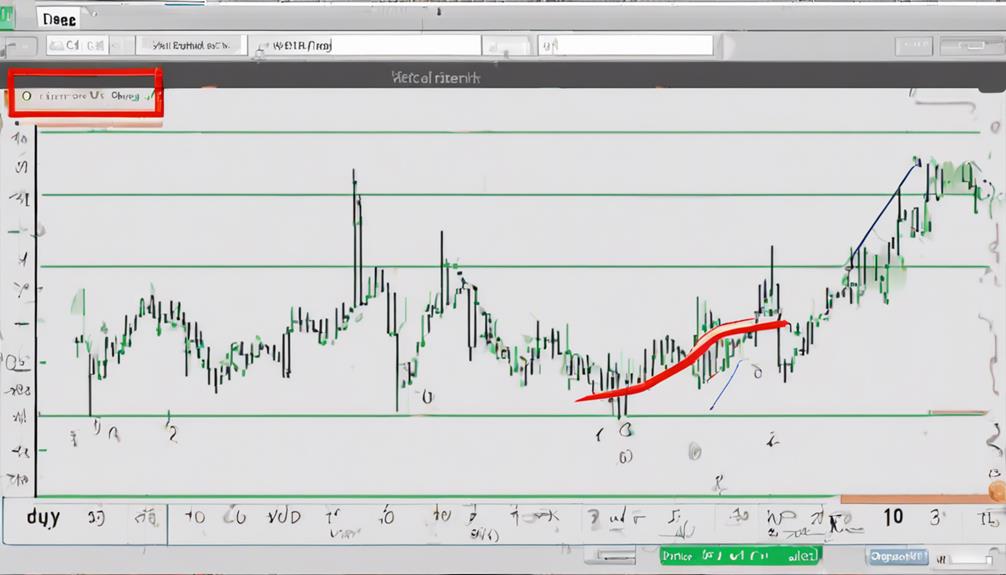
Identifying signal line crossovers plays a crucial role in determining trading signals for entry and exit points in Forex markets. When the MACD line crosses above the signal line, it generates a bullish signal. Conversely, a bearish signal is produced when the MACD line crosses below the signal line.
These crossovers are significant as they help traders pinpoint potential changes in momentum and identify potential trend reversals. By observing the interactions between the MACD and signal lines, traders can make informed decisions about when to enter or exit trades.
Understanding the implications of these crossovers is essential for utilizing the MACD indicator effectively in Forex trading strategies.
Analyzing Overbought/Oversold Levels
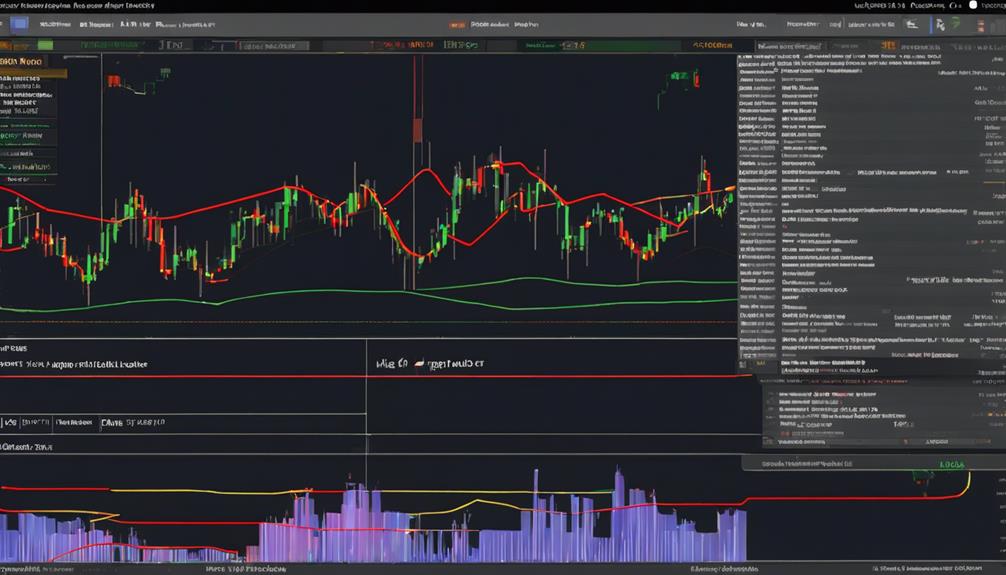
Analyzing overbought/oversold levels in the MACD indicator is crucial for determining potential buying or selling opportunities in Forex trading.
Overbought levels occur when the MACD rises significantly above the zero line, signaling possible selling pressure, prompting traders to consider selling positions or taking profits.
Conversely, oversold levels happen when the MACD drops notably below the zero line, indicating potential buying opportunities or entry points for new positions.
Monitoring the MACD for these overbought/oversold signals enables traders to make informed decisions based on market momentum.
Understanding these levels allows traders to assess the strength of a trend and anticipate possible reversals, enhancing their ability to time their trades effectively in the dynamic Forex market.
Recognizing Zero Line Crossovers
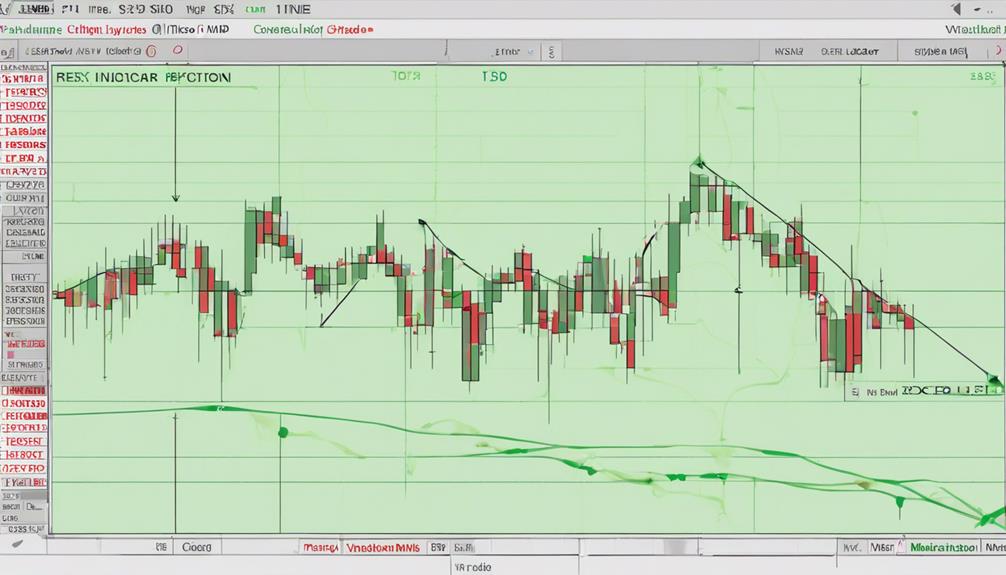
Recognize zero line crossovers in the MACD indicator as key signals for determining shifts in market momentum and potential trade opportunities in Forex trading. When the MACD line crosses the zero line, it provides crucial insights into market sentiment. Here's what you need to know:
- MACD line crosses zero line are significant events.
- Crossing above zero indicates a bullish signal.
- Crossing below zero signifies a bearish signal.
- Traders use these crossovers to confirm trend changes.
- Monitoring zero line crossovers helps in identifying entry or exit points.
Understanding these signals can aid in making informed trading decisions based on the strength and direction of price trends.
Detecting Divergences in MACD
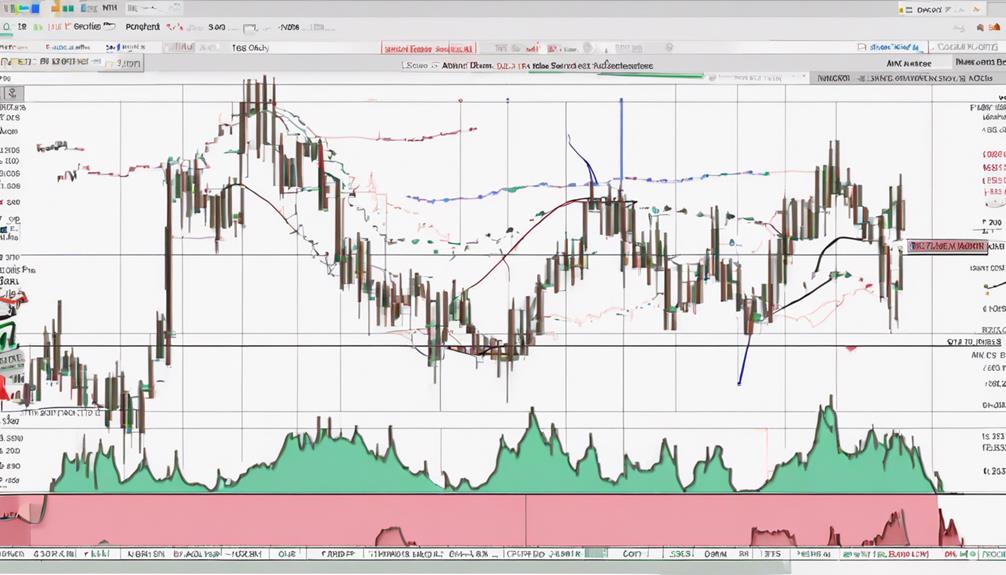
When observing the MACD indicator, detecting divergences serves as a critical method for anticipating potential trend reversals or shifts in market momentum. Divergences in MACD occur when the price direction deviates from the movement of the indicator, signaling a possible change in market sentiment.
A bullish divergence materializes when the price forms lower lows while the MACD shows higher lows, suggesting a potential upward trend reversal. Conversely, a bearish divergence manifests when the price creates higher highs while the MACD displays lower highs, indicating a potential downward trend reversal.
Traders keen on using MACD divergences analyze these signals to forecast price movements accurately and adjust their trading strategies accordingly to capitalize on potential market shifts.
Interpreting Bullish and Bearish Signals
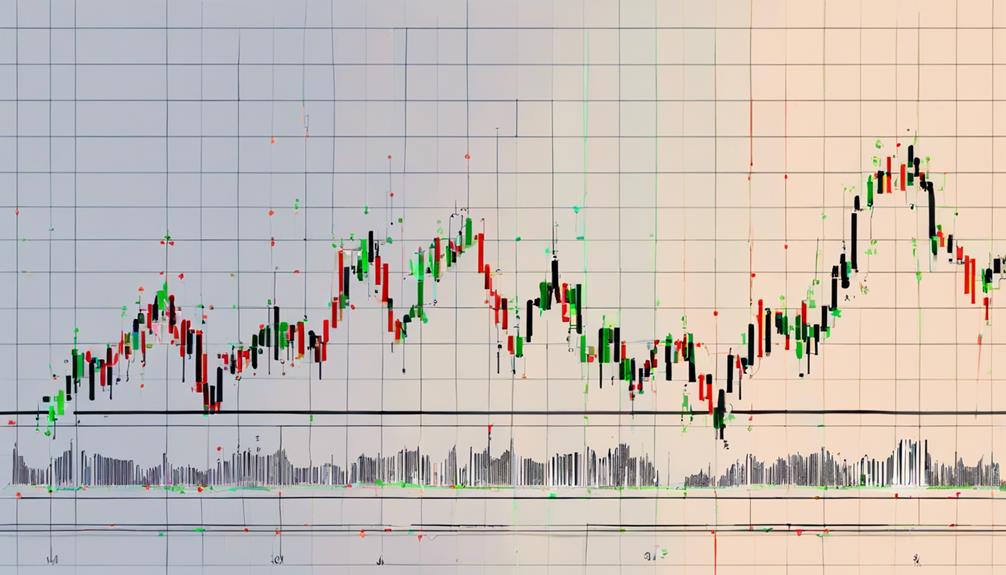
When analyzing the MACD indicator in Forex trading, identifying bullish signals is crucial for capturing potential uptrends.
Conversely, recognizing bearish signals can help you navigate potential downtrends in the market effectively.
Employing signal confirmation techniques can enhance your ability to make informed trading decisions based on MACD signals.
Bullish MACD Signals
To identify a bullish MACD signal in Forex trading, observe the moment the MACD line crosses above the signal line. This occurrence indicates a potential buying opportunity as it suggests increasing upward momentum in the market. Traders often interpret bullish MACD signals as favorable for entering long positions, anticipating a shift towards a positive trend in currency pairs. When analyzing MACD signals, keep in mind that a bullish signal can signify a strengthening market sentiment and potential price appreciation. Remember to consider other aspects of technical analysis and market conditions to make well-informed trading decisions.
- Bullish MACD signal occurs when MACD line crosses above the signal line.
- Interpret bullish signals as potential buying opportunities in Forex trading.
- Bullish MACD signals suggest increasing upward momentum in the market.
- Traders may consider entering long positions when bullish MACD signals are identified.
- Bullish MACD signals can indicate a shift towards a positive trend in currency pairs.
Bearish MACD Signals
Bearish MACD signals in Forex trading are identified when the MACD line crosses below the signal line. This crossover indicates a potential downtrend and presents a selling opportunity to traders. It signifies weakening momentum in the market, suggesting a shift towards bearish sentiment.
By recognizing these signals, traders can anticipate downward price movements and adjust their strategies accordingly. Monitoring bearish MACD signals is crucial for risk management and decision-making, allowing traders to capitalize on market movements.
Understanding the implications of bearish signals helps traders stay ahead of market trends and make informed choices to navigate the complexities of Forex trading effectively.
Signal Confirmation Techniques
Utilizing various techniques for signal confirmation is imperative in interpreting both bullish and bearish signals in MACD indicators in Forex trading. When analyzing MACD signals, traders rely on specific criteria for confirmation:
- Bullish Signal Confirmation: MACD line crossing above the signal line.
- Bearish Signal Confirmation: MACD line crossing below the signal line.
- Bullish Momentum: MACD histogram increasing above zero.
- Bearish Momentum: MACD histogram decreasing below zero.
- Validation Techniques: Traders use multiple methods to confirm signals and make informed trading decisions based on MACD indicators.
Utilizing MACD in Forex Trading Strategies
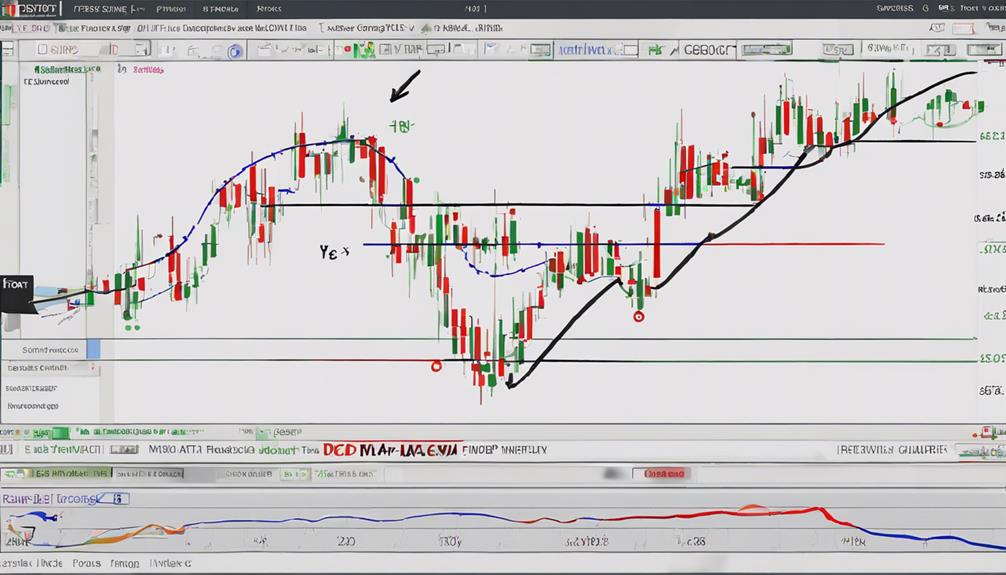
When trading with MACD, remember that the signal line crossing above the MACD line is a bullish signal, while the opposite indicates a bearish trend.
Analyzing the MACD histogram can provide further insight into market momentum shifts.
Incorporating these interpretations into your trading strategies can enhance your decision-making process in the Forex market.
Trading With MACD
To effectively incorporate MACD into your Forex trading strategies, focus on identifying changes in trend direction and momentum. Utilize MACD to confirm trade entries aligning with established trends.
When trading with MACD, look for key signals such as crossovers, overbought/oversold levels, and divergences to inform your decisions. Remember, market sentiment tends to be bullish when MACD is above zero and bearish when below zero in Forex trading.
For a more comprehensive analysis, consider combining MACD signals with other technical indicators to gain a deeper insight into market movements.
- Confirm trade entries with MACD
- Watch for crossovers, overbought/oversold levels, and divergences
- Market sentiment: above zero (bullish), below zero (bearish)
- Combine MACD signals with other technical indicators
MACD Signal Line
The MACD signal line, derived from the 9-day EMA of the MACD line, plays a crucial role in generating buy or sell signals for traders in Forex trading.
Traders closely monitor the crossovers between the MACD line and the signal line as key trading signals. When the MACD line crosses above the signal line, it indicates a potential bullish trend, signaling a buy opportunity.
Conversely, when the MACD line crosses below the signal line, it suggests a bearish trend, signaling a potential sell opportunity. By understanding and utilizing these crossovers, traders can confirm trends and make informed decisions in the Forex market.
Mastering the relationship between the MACD line and the signal line is vital for developing successful trading strategies using the MACD indicator.
MACD Histogram Interpretation
Peaks and troughs observed in the MACD histogram serve as key indicators for interpreting price momentum shifts in Forex trading strategies. When analyzing the MACD histogram, traders look for specific patterns and movements to make informed decisions.
Here are essential points to consider:
- Momentum Shifts: Histogram peaks and troughs signal changes in price momentum.
- Convergence towards Zero Line: Approaching the zero line suggests a potential trend reversal.
- Bearish and Bullish Divergences: Variances between price action and the histogram can hint at upcoming reversals.
- Buy and Sell Signals: Traders use histogram trends to identify optimal entry and exit points.
- Trend Analysis: Monitoring the histogram helps in gauging the strength and direction of a trend.
Assessing Advantages and Disadvantages

Assessing the MACD indicator in Forex trading involves weighing its distinct advantages and disadvantages to make informed decisions.
The moving average convergence divergence (MACD) is valuable for providing trading signals based on momentum. Its advantages lie in signaling market direction when above or below zero. However, a drawback is its tendency to lag behind price action. Additionally, the MACD lacks predefined stop loss or take profit levels, which can be a disadvantage for some traders.
To enhance its effectiveness, consider combining the MACD with other tools for better signal filtration. Utilizing indicators like Envelopes and ADX alongside the MACD can further improve analysis and trading decisions in the Forex market.
Implementing MACD for Informed Trading Decisions
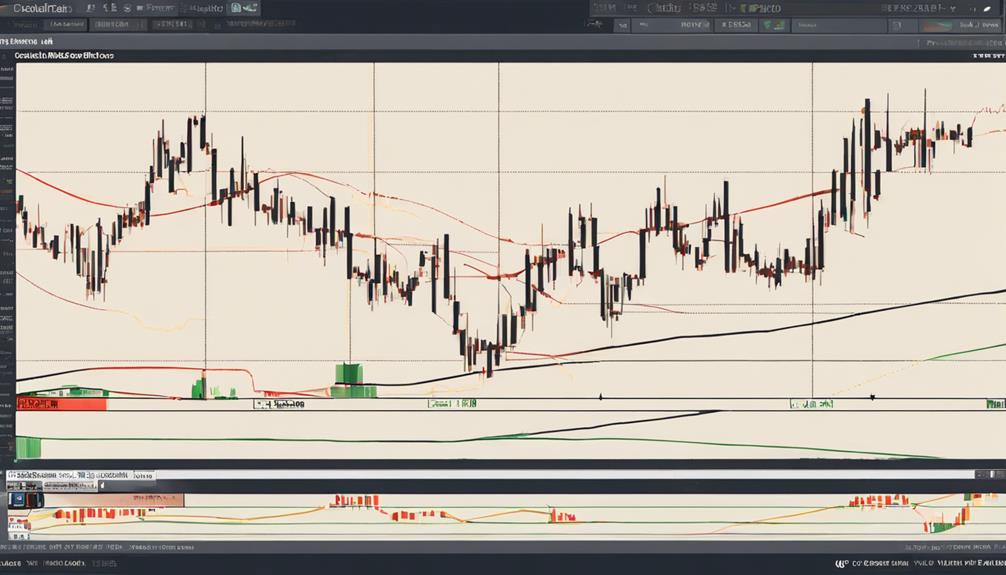
When applying the MACD indicator for informed trading decisions in Forex, focus on customizing its parameters to align with your trading goals and timeframes. It's essential to tailor the settings of the Moving Average Convergence Divergence indicator to suit your specific needs.
Here's how you can implement MACD effectively:
- Adjust the MACD parameters based on your trading objectives.
- Utilize MACD signals to identify potential trading opportunities.
- Combine MACD crossovers with other technical indicators for confirmation.
- Use MACD to determine overbought or oversold conditions in the market.
- Consider the zero line crossover and divergences for enhanced trading strategies.
Customizing MACD can help you make more informed trading decisions in the Forex market.
Can you explain the 10 steps to interpret the MACD indicator in forex trading?
The 10 steps to interpret the MACD indicator in forex trading are crucial for investors. First, understand the MACD line’s crossovers to anticipate trend changes. Second, recognize the signal line crossovers for buy and sell signals. Third, analyze the MACD histogram for momentum shifts. Mastering the macd indicator in forex is essential for successful trading.
Frequently Asked Questions
How Do You Interpret MACD Indicators?
To interpret MACD indicators, watch for crossovers above zero for bullish trends and below zero for bearish sentiment. Combine with signal line for buy/sell signals. Seek turning points for trading opportunities. Confirm trends and momentum in Forex markets with MACD.
How to Use MACD for Forex Trading?
When using MACD for Forex trading, you'll focus on trend changes and momentum. Remember, the market is bullish when MACD is above 0 and bearish when below. Align your trades with MACD signals for success.
How Do You Read MACD Strategy?
To read MACD strategy, observe positive values for bullish momentum and negative values for bearish momentum. Watch for crossovers between the MACD line and signal line for buy or sell signals. Look for divergences and growing histogram bars indicating momentum.
What Is the Best Strategy to Use With Macd?
To make the most of MACD in Forex trading, combine it with indicators like RSI and SMA for a thorough analysis. Implement strategies such as crossovers, zero-crosses, and divergences. Enhance accuracy by adding tools like the Money Flow Index and Relative Vigor Index.
Conclusion
In conclusion, mastering the MACD indicator in Forex trading can significantly improve your ability to identify trends and make informed trading decisions.
Did you know that according to a study by FXSSI, the MACD indicator is one of the most widely used technical analysis tools among Forex traders, with over 70% of them incorporating it into their trading strategies?
By understanding its basics and implementing it effectively, you can enhance your trading success.
